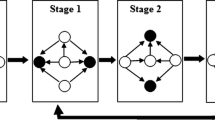Abstract
Caterpillar crawling is distinct from that of other limbless animals. It is simple but efficient. This paper presents a novel mechanism to duplicate the movement to a modular caterpillar-like robot. First, how caterpillars move in nature is investigated and analyzed systematically. Two key locomotive properties are abstracted from the body shape of caterpillars during crawling. Then, based on a morphological mapping, a hypothesis of asymmetric oscillation with a ratio of two is proposed, followed by a thorough analysis of the kinematics of the caterpillar-like robot. The asymmetric oscillating mechanism is proved capable of generating stable caterpillar-like locomotion. Next, taking advantage of the two locomotive properties and the hypothesis, a new Central Pattern Generator (CPG) model is designed as the controller of the robot. The model can not only generate the signal as expected, but also provide explicit control parameters for online modulation. Finally, simulation and on-site experiments are carried out. The results confirm that the proposed method is effective for caterpillar-like locomotion.
Similar content being viewed by others
References
Carl G. Locomotion of limbless vertebrates: Pattern and evolution. Herpetologica, 1986, 42, 33–46.
Hirose S, Yamada H. Snake-like robots. Robotics & Automation Magazine, 2009, 16, 88–98.
González-Gómez J, Aguayo E, Boemo E. Locomotion of a modular worm-like robot using a FPGA-based embedded microblaze soft-processor. Proceeding of the 7th International Conference on Climbing and Walking Robots, Madrid, Spain, 2004, 869–878.
Wang W, Wang K, Zhang H X, Zhang J W. Internal force compensating method for wall-climbing caterpillar robot. Proceedings of the 2010 IEEE International Conference on Robotics and Automation, Alaska, USA, 2010, 2817–2820.
Cai Y, Bi S, Zheng L. Design and experiments of a robotic fish imitating cow-nosed ray. Journal of Bionic Engineering, 2010, 7, 120–126.
Hopkins J K, Spranklin B W, Gupta S K. A survey of snake-inspired robot designs. Bioinspiration & Biomimetics, 2009, 4, 1–19.
Yim M, Duff D, Roufas K. Polybot: A modular reconfigurable robot. Proceeding of 2000 IEEE International Conference on Robotics and Automation, San Francisco, USA, 2000, 514–520.
Kurokawa H, Tomita K, Kamimura A, Kokaji S, Hasuo T, Murata S. Distributed self-reconfiguration of M-TRAN III modular robotic system. The International Journal of Robotics Research, 2008, 27, 373–386.
Rus D, Vona M. Crystalline robots: Self-reconfiguration with compressible unit modules. Autonomous Robots, 2001, 10, 107–124.
Hirose S. Biologically Inspired Robots, Oxford University Press, London, UK, 1993.
Crespi A, Badertscher A, Guignard A, Ijspeert A J. Swimming and crawling with an amphibious snake robot. Proceedings of the 2005 IEEE international conference on robotics and automation, Barcelona, Spain, 2005, 3024–3028.
Yamada H, Hirose S. Development of practical 3-dimensional active cord mechanism ACM-R4. Journal of Robotics and Mechatronics, 2006, 18, 305–311.
Borenstein J, Hansen M, Borrell mniTread OT-4 serpentine robot-design and performance. Journal of Field Robotics, 2007, 24, 601–621.
Grillner S. Neurobiological bases of rhythmic motor acts in vertebrates. Science, 1985, 228, 143–149.
Ijspeert A J. Central pattern generators for locomotion control in animals and robots: A review. Neural Networks, 2008, 21, 642–653.
Chirikjian G, Burdick J. The kinematics of hyper-redundant robot locomotion. IEEE Transactions on Robotics and Automation, 1995, 11, 781–793.
Yim M. Locomotion with Unit-Modular Reconfigurable Robot, PhD thesis, Stanford, CA, USA, 1994.
Li G Y, Zhang H X, Herrero-Carrón F, Hildre H P, Zhang J W. A novel mechanism for caterpillar-like locomotion using asymmetric oscillation. Proceedings of the 2011 IEEE International Conference on Advanced Intelligent Mechatronics, Budapest, Hungary, 2011, 164–169.
Brackenbury J. Caterpillar kinematics. Nature, 1997, 390, 453–453.
Brackenbury J. Fast locomotion in caterpillars. Journal of Insect Physiology, 1997, 45, 525–533.
Trimmer B A, Issberner J. Kinematics of soft-bodied, legged locomotion in manduca sexta larvae. Biological Bulletin, 2007, 212, 130–142.
Lin H T, Trimmer B A. The substrate as a skeleton: Ground reaction forces from a soft-bodied legged animal. Journal of Experimental Biology, 2010, 213, 1133–1142.
Trivedi D, Rahn C D, Kier W M, Walker I D. Soft robotics: Biological inspiration, state of the art, and future research. Applied Bionics and Biomechanics, 2008, 5, 99–117.
Marbach D, Ijspeert A J. Online Optimization of Modular Robot Locomotion. Proceedings of the 2005 IEEE International Conference on Mechatronics and Automation, Niagara Falls, Canada, 2005, 248–253.
Smith R, Open dynamics engine, http://www.ode.org/
Zhang H, Gonzalez-Gomez J, Xie Z, Cheng S, Zhang J. Development of a low-cost flexible modular robot GZ-I. Proceeding of the 2008 IEEE/ASME International Conference on Advanced Intelligent Mechatronics, Xian, China, 2008, 223–228.
Casey T M. Energetics of caterpillar locomotion: Biomechanical constraints of a hydraulic skeleton. Science, 1991, 252, 112–114.
Van Griethuijsen L I, Trimmer B A. Kinematics of horizontal and vertical caterpillar crawling. Journal of Experimental Biology 2009, 212, 1455–1462.
Author information
Authors and Affiliations
Corresponding author
Rights and permissions
About this article
Cite this article
Li, G., Li, W., Zhang, J. et al. Analysis and Design of Asymmetric Oscillation for Caterpillar-Like Locomotion. J Bionic Eng 12, 190–203 (2015). https://doi.org/10.1016/S1672-6529(14)60112-8
Published:
Issue Date:
DOI: https://doi.org/10.1016/S1672-6529(14)60112-8




